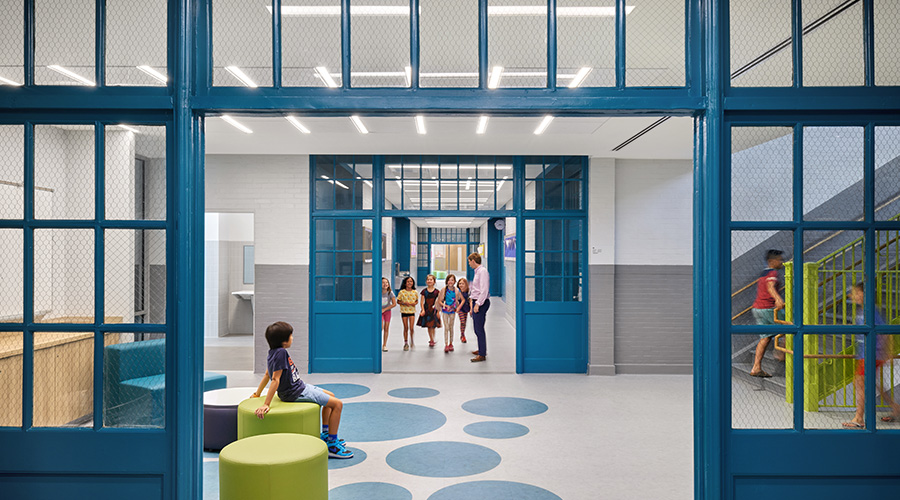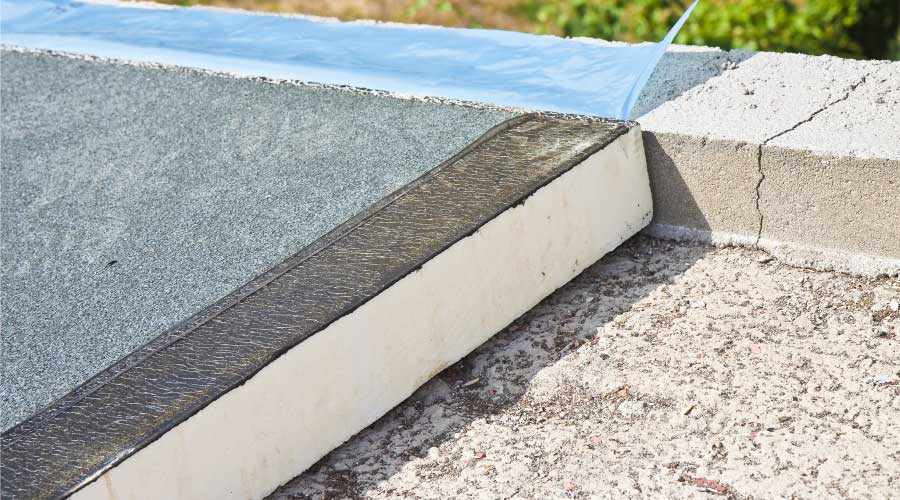Raymond Elementary Combines History and Sustainability
Raymond Elementary School renovated to meet LEED, WELL and net-zero goals.
By Maura Keller, Contributing Writer
Located in Washington, D.C., Raymond Elementary School synthesizes the goals of historic preservation and sustainability in an urban educational setting. Completed in July 2023, the fully modernized and expanded space features a new gymnasium, library, classrooms, and an enhanced entry sequence. The 96,000-square-foot school and campus is designed to meet LEED Gold and WELL standards and is expected to achieve Net Zero Energy Certification. One hundred years old this year, Raymond Elementary has been redesigned for the next 100 years.
“Mayor Muriel Bowser is committed to the education of our children and youth and to the facilities in which they learn,” says Delano Hunter, acting director at the Department of General Services (DGS). “Under her leadership, Raymond Elementary School was renovated per the DC PACE Act, which prioritizes all DC Public Schools in terms of the order in which they are modernized. The scope included demolition of the 1960s wing and a full renovation of the existing 1920s historic building, including all new finishes, building systems and technology. The new building opened as we marked the centennial celebration for the school.”
STUDIOS Architecture, together with the design-build contractor MCN Build and engineering partner, Global Engineering Solutions, led the effort to modernize and expand the existing 1920s-era building.
The WELL certification is a combination of constructed elements and building operations that focuses on the enhancement of the health of the building’s occupants. For example, air quality, water quality, healthy materials and operations are elements of WELL.
The school’s sustainability commitment shines through with LEED Gold and Net Zero Energy Certifications as the targets, says Rachel Kenney, associate principal at STUDIOS Architecture. More than 100 geothermal wells, solar canopies, and energy-efficient systems were integrated to achieve this goal, all while meticulously preserving the historical integrity of the building.
“Net zero is the status where the energy produced by the building through renewables like solar/PV will meet or exceed the energy consumed by a building over the course of a year,” Hunter says. “While DGS has delivered three other net zero schools to date, Raymond was the first school that had a significant historic portion.”
The building’s redesign emphasizes creating strong connections between people and the natural environment. The building is organized around a central play courtyard with convenient access from multiple locations within the building.
“Major building programs such as the cafeteria, gymnasium, and library all receive borrowed light and have strong view connections to the courtyard, allowing the interior of the school to always feel connected to the outdoors,” Kenney says. “The central courtyard also serves to improve school safety and security by creating a protected outdoor space where faculty can easily monitor the children and ensure their safety.”
From a sustainability standpoint, the building has a water-sourced heat pump system, which is supported by geothermal wells placed around the site. The building also has a power purchase agreement with solar power on the roof and a canopy above the parking area, says Hunter.
Net-zero know-how
To reach net zero, the project relied on multiple energy efficiency measures to reach the target EUI score of 21.5.
“Attaining a net zero score in this first of a kind historic building project, relied on out-of-the-box thinking that needed the highest efficiency out of the mechanical, lighting and plumbing systems,” says Chad Sullivan, associate vice president, director of mechanical engineering at Global Engineering Solutions (GES). “It was crucial to reduce the heat gains into the building as much as possible, while also using controls to turn off or reduce equipment and systems’ energy based on the demand of the building.”
At all the windows, the design team incorporated automatic motorized window shades with a reflective silverscreen backing that, when in the down position, reduced the shading coefficient (SC) equal to 0.09. This shading system includes controls that lower the shades when the sun is out, when it is hot outside, and when the position of the sun is shining directly at the windows, Sullivan says.
At night, the shades lower to a down position to reduce radiated heat out through the glass during colder outside temperatures. During the winter, the shades stay in the open position to allow sunshine through the windows and help heat the space. An override switch in each classroom allows teachers to fix the position of the shades to their preference.
The pumping system was designed to be a single primary variable loop, that circulated the water through the geothermal wellfield and then through the building water source coils.?The four primary pumps with variable speed drives allow for the circulation system to turn down to a minimum of 6 percent at night and on weekends, ensuring minimum flow to critical IT rooms that call for cooling on a 24/7 basis.
“The geothermal system piping was designed without any glycol or heat exchangers, which was done to maximize heat transfer efficiency at the water sourced coils,” Sullivan says.
Controls and heat tracing (on backup power) protects against freezing, even during power outages in the winter.
“The geothermal loop was also designed with a modulating wellfield bypass valve, that reduces pump head when the temperature of the condenser loop is satisfied but flow is still needed at the water-sourced coils,” Sullivan says. “This was a novel idea that we have never used or seen on a geothermal project before — and was used on this project to maximize pump efficiency.”
Ventilation for this project was calculated using the VRP method. Ventilation is direct ducted into the rooms and is decoupled from the air conditioning system. Carbon dioxide sensors modulate the VAV box dampers in each classroom based on occupancy demand. The dedicated outside air system (DOAS unit), which includes an energy recovery wheel and variable speed fans, reduced fan speed based on building ventilation demand.
Lighting for the building was designed based on 0.50 w/sf. Lighting controls, which include daylight dimming sensors, and occupancy sensors, reduce lighting energy based on available sunlight and occupancy in the rooms, Sullivan says.
In addition, hot water fixtures were designed to be ultra-low-flow. The classroom sinks have aerators that reduce gallons per minute (gpm) to 0.35 and the shower heads have 0.65 gpm flow. Automatic controls on most sinks turn off water when not in use. Domestic hot water was generated by a water source heat pump tied into the geothermal system.
“This increased the energy efficiency of the condenser water loop, while also balancing out the geothermal wellfield temperatures,” Sullivan says. “Also, classroom smartboards and 50 percent of the receptacles in each space are controlled by occupancy sensors and automatically turn off when not in use.”
Embracing challenges
Incorporating this level of sustainability within a 100-year-old building brings about a certain level of challenges.
“The biggest challenge was making a historic building net-zero, as, to reduce the energy consumption of the building, DGS had to make significant upgrades to the envelope (i.e., the walls and roof), which sometimes thickened the walls by as much as six inches of insulation,” Hunter says.
This also was one of the first net-zero projects that D.C. has taken on, especially in a building that retained existing infrastructure.?As such, there were limitations for tightening and insulating historic walls that have never seen insulation before.
“There were challenges that involved researching the net-zero requirements, defining a net-zero score, and determining the most cost-effective approach to meet net zero based on the established budget,” Sullivan says. “Since reaching net-zero design is a team effort across multiple disciplines, teamwork, engagement and communication was crucial to reach the target energy use intensity (EUI) score, which indicates a measurement of a building’s energy consumption with its size taken into account. The Raymond project was very fortunate to have willing, committed and engaged owners, contractor, engineers and consultants all working together towards this common goal.”
The design team also designed a sustainability dashboard interface that has been incorporated into all of D.C.’s net-zero projects moving forward as a standard dashboard interface. The dashboard communicates the building's performance based on the many energy and electricity meters installed on the project.
Improved environment
The most important result of the redesign of Raymond Elementary is that, first and foremost, the children have a new and modern space where they can learn, which exemplifies the latest D.C. Public School standards. Second, the building is thus far exceeding its energy goals. The project had a target EUI of 22, and thus far has an EUI at around 20.
“Mayor Bowser continues her vision for school modernizations for these types of favorable outcomes,” Hunter says. “In her proposed fiscal year ’25 budget, she is investing $2.2 billion to support full modernization of 33 additional schools across the district.”
Kenney adds that the modernization project embodies the ideals of inclusive design through its process and results. From the integration of neighborhood-serving programmatic functions and enhanced safety and security for students, to preservation of historic resources and the highest levels of sustainability, the ultimate result is an inclusive learning environment the community can take pride in for generations to come.
“Working closely with all school, community, and government stakeholders, the design-build team successfully synthesized aspirational goals with budget and time constraints,” Kenney says. “We created a fully integrated solution that is not only designed for the future but is also respectful of the history and legacy of its context.”
Maura Keller is a freelance writer based in Plymouth, Minnesota.
Related Topics:












